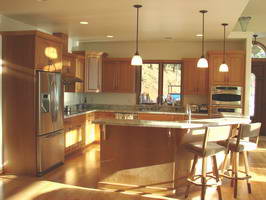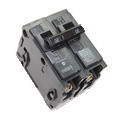Connecting a Generator to a Home Videos
 '; ';
|
How to Connect a Generator to a Home: Safe Methods for Connecting a Home Generator, Approved Transfer Switch, Circuit Breaker Interlock Kit, Well Pumps and other 220 Volt Circuits, Sensitive Electronic Devices and Equipment, Connecting the Generator. © By: Dave Rongey |
Safe Methods for Connecting a Home Generator
Electrical Question: I’m trying to wire up my generator to my home for emergency use.
Yes, I know to turn the main breaker OFF while using the generator so as not to back feed the power lines.
- My Generator has a 30 amp 4 wire 220vac plug and I making an extension cord to back feed my home through the welding plug(the cord has 4 wires,red,green,black and white) my welding plug only has three wires?
- Do I connect the white (common) and the green wire together on the welding plug?
- I want to run my well pump that is 220 volt with the generator.
Thanks,
William
This electrical question came from: William, a Handyman from Fayetteville, North Carolina.
Dave’s Reply:
Thanks for your electrical question William.
How to Connect a Generator to a Home

Application: Wiring a Generator to a Home.
Skill Level: Intermediate to Advanced – Licensed Electrical Contractor, Not Recommended for Homeowners
Tools Required: Electricians Pouch of Hand Tools for Generator Installation and Circuit Wiring.
Estimated Time: Depends on the size of the generator, type of transfer switch, number of circuits and available access to the project area.
Precaution: This is an extensive project that should be performed by a Licensed Electrical Contractor.
Notice: Installing a home generator, transfer switch, or circuits should be done with a permit and be inspected.
Important Consideration before Connecting a Generator to a Home
Process of The following is an example of the Methods for Connecting a Home Generator including an Approved Transfer Switch or Circuit Breaker Interlock Kit. Special considerations should be given to Well Pumps and other 220 Volt Circuits, as well as Sensitive Electronic Devices and Equipment before Connecting the Generator.
- Approved Transfer Switch
Connections of any generator to a home electrical system should always be performed by wiring through a transfer switch and circuit protection which disconnects and isolates the different power power sources. - Circuit Breaker Interlock Kit
One option to a conventional transfer switch is to use an approved interlock kit which will require the main circuit breaker of the panel to be OFF before the interlock switch circuit breaker may be turned ON. This is a very economical alternative to an expensive transfer switch, however it can only be used with compatible electrical panels. When using this method, the generator cord connections are made inside the electrical panel as described in the installation manual. - Sizing the Generator
The amount of electrical power from the generator and the home electrical circuits must be considered when creating an appropriate transfer switch and circuit design. - Well Pumps and other 220 Volt Circuits
Special attention should be given to all 220 volt circuits that will be placed on generator power. Many generators do not have the capability to supply power for a well pump. Make sure to ask about the types of electrical loads that are compatible with the generator that you are considering. - Sensitive Electronic Devices and Equipment
A generator that is designed to be used at a construction site may not be ideal for a home where sensitive electronic devices will be used. Consider selecting a generator that comes with regulates the voltage and has built in voltage suppression and conditioning. - Connecting the Generator
The most common method for connecting a generator to a home is by using a 4-wire cord and plug which is sized and compatible with the receptacle outlet that is found on the generator. The wiring of this cord is made up into the transfer switch enclosure.
IMPORTANT: Back feeding a home with generator power is NEVER recommended due to a variety of hazardous conditions that will be produced as a result of this dangerous practice.
NOTE: If it is not possible to install a transfer switch then use extension cords to connect the generator power to appliances in the home that will require power, such as the refrigerator.
More about Wiring Home Generators
- Installing a Home Generator and Transfer Switch

Home Generator Systems
This series covers a wide variety of topics all about home generators including sizing, selecting, connecting and safely operating this all important addition to your home. - Home Circuit Breaker
Electrical Wiring Protection using Circuit Breakers
A guide to home electrical circuit breakers and how they work to protect your electrical wiring. When properly installed, your home electrical wiring is protected by a circuit protection device. - Electrical wire
Electrical Wire for the Home
Complete listing of electrical wire types and parts used for home projects with electrical code information serves as selection guidelines.
The following may also be helpful for you:
|
|
Be Careful and Be Safe - Never Work on Energized Circuits!
Consult your Local Building Department about Permits and Inspections for all Electric Wiring Projects.
More articles about Connecting a Generator, Electrical Wiring, Generators, Transfer Switch and Home Electrical Wiring: |
|
| « Previous | Next » |
Kitchen Tile and Electrical Outlets and Wiring |
Are You Making These Costly Electrical Wiring Mistakes |
















